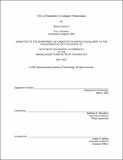The C-Propeptide in Collagen Proteostasis
Author(s)
Li, Rasia (Chichi)
DownloadThesis PDF (4.438Mb)
Advisor
Shoulders, Matthew D.
Terms of use
Metadata
Show full item recordAbstract
Collagen folding is initiated at the C-terminal propeptide (C-Pro) domain, a globular domain wholly distinct from the collagen’s characteristic triple helix. The C-Pro domain is responsible for assembling three collagen strands into the correct orientation and stoichiometry and nucleating folding of the most abundant protein in the human body. While the function of the C-Pro domain in guiding collagen assembly is well accepted, its role in proteostasis has only recently been appreciated. In Chapter 2, we demonstrate that the highly-conserved N-glycan in the collagen-I C-Pro domain is critical for maintaining collagen proteostasis under challenging conditions. Specifically, the N-glycan facilitates interaction between procollagen and ER lectin chaperones to ensure proper folding of misfolding-prone collagen variants or wild-type collagen under proteostatic stress. In Chapter 3, we present progress towards understanding the molecular mechanisms of collagen assembly. We previously showed that collagen-I C-Pro assembly patterns are guided by Ca2+ -dependent non-covalent assembly of all C-Pro trimers, followed by covalent immortalization by interchain disulfide bonds. While prior work focused on the C-Pro domains in isolation, Chapter 3 explores unanswered questions about collagen assembly using full-length procollagen constructs. We show that regions of procollagen beyond the C-Pro domain play an unexpected role in defining the ability of triple-helical domains to homotrimerize. These results also yield fresh insights into the still unknown molecular features that promote procollagen heterotrimerization. Collectively, the work described in this thesis advance our understanding of the critical roles of the C-Pro domain in collagen proteostasis.
Date issued
2022-05Department
Massachusetts Institute of Technology. Department of ChemistryPublisher
Massachusetts Institute of Technology